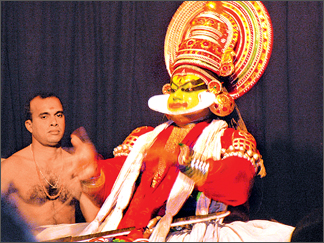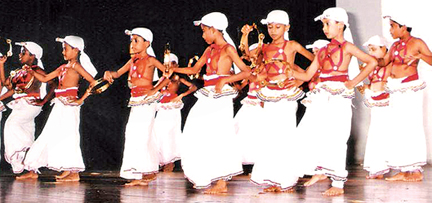Varying Tamil dance forms
Subashini Pathmanathan
[Generally worn ornaments and clothing]
* Long silver chains
* Ear-stud pendants
* Shoulder bands
* White turbans
* Jingling bells
* Anklets
* Different kinds of beadwork decorations
* Handkerchiefs

Kathakali dance |
Another dance form in Kandyan is Naiyandi dance which includes with
wide steps and narrow steps. These steps are sometimes closer to each
other and sometimes the gaps between are wider and vast. Yet the dance
has some graceful movements.
In Tamil the word Naiyandi is still in use. In Tamil culture there
was an orchestra called Naiyandi Melam which is still used in Tamil
areas of Sri Lanka. It includes two Nagaerswara players: one Tavil
player (temple drum), another a drum called Pambai played by two drum
players, and another drum Kirikatti played only by one single drummer.
The Naiyandi Melam music records are available freely in shops.
In Kandyan Naiyandi, the dancer wears white costumes; the chest is
covered with rows of bead chains which are worn like Kathakali dancers
of Kerala. This is made out of beautiful beads. Besides these they wear
long silver chains, ear-stud pendants, they also wear shoulder bands,
and white turbans are worn by the Nayandi dancer.
In Kathakali also almost the same type ofbeautiful beadsare worn,
except the turban. In both the dances, the dancers wear jingling bells,
and anklets. The white turban, ear stud pendants, jingling bells, and
anklets are worn by the male Manipuri dancers of India.
The Naiyandi dance was earlier practised in the royal courts. The
steps are narrow and vast extended movements like Kathakali.
This dance was practised in the royal courts like Kahakali in early
days. Even the Manipuri male dancers carry the drums like the Kandyan
Ves dancers and wear white turban. The Manipuri male dancers also wear
white colour costumes.
Another Kandyan dance form is Udekki.This dance Udekki was named
because of the instrument Udekki is usedin this dance form. InKandyan
dance Udekki is another category of dance, which is derived from the
drum named Udukki. It?s Udduku in Tamil. In Bharatha Natyam also this
drum plays an important role, because the Thandava Murthi Lord Nataraja
in the Sabtha Thandava as well as in the 108 Thandava Karanas of Lord
Siva bears the Udduku (Udekki).
This drum Udekki, is always found in the right hand of Thandava
Murthi Lord Nataraja. It is believed in Thiru Manthiram that all
creations origin out of the sound of Uddukku. There is a line which
refers to the sound of Udduku: Thotrum thudi thanil (which means that
all the creations originates from the sounds of Udduku). This Udduku
also plays an important role in Hindu rituals. Still the magicians and
fortunetellers use this instrument.
|

Pantheru dance group |
The shape of the Udekki is like an hourglass, and the length of the
Uddeki is almost seven and half inches. It is a portable and small drum.
It is believed two drum skins are given by Lord Iswara, and the sound
for the drum is given by the Lord Vishnu. And it was further believed
that the Udekki was made according to the instructions of the Sakra.
This drum symbolizes speech and magic. According to Hindu mythology,
the wind originated from the same Uddukku (Udekki). Still for Tamil folk
music, even in certain Hindu classical dances and Hindu rituals
dancesUddukku is used.
PantheruisanotherKandyan dance form. The dancer carries the
instrument called Pantheruwa, used in turning and twirling, and changing
from one hand to another hand. The dancers dance with another thala,
laya, and another drum instrument called Geta-bera.
The Pantheruwa is an instrument connected to the Goddess Pathini
cult. It is decorated with small cymbals, and these cymbals are attached
in regular intervals around the instrument. Further it was believed that
Gods used this instrument to celebrate the victory. Earlier the Sinhala
Kings employed Pantheru dancers to celebrate their victories in the
battle field.
The costumes used in this dance form are almost similar to the Udekki
dancers. But the Pantheru dancers do not wear bead jackets to cover the
chest like Udekki and Kathakali dancers.
They wear a handkerchief around the waist. The male dancers of Tamil
folk dance Thevarattam use handkerchiefs too. But the dancer has a white
pleated garment, the chest and the neck are decorated with bead work,
shoulder is decorated with shoulder kavasams, (shoulder plates), ear
pendants, armlets, and bracelets.
The feet are decorated with jingling bells, and anklets. This
particular dance served for the purpose of military band. Such type of
dance was danced earlier in Tamil culture.
According to Tamil literature, like Muntheer kuravai, and Peentheer
kuravai, dances were performed to celebrate the victory of the
victorious king. Hence the relationship of Naiyandi, Udekki, and
Pantheru dance forms of Kandyan dance have one way or other way have
connected toIndian dances. |



